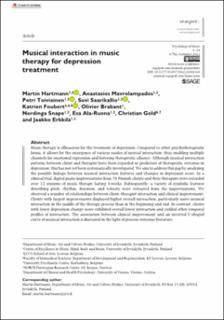| dc.contributor.author | Hartmann, Martin | |
| dc.contributor.author | Mavrolampados, Anastasios | |
| dc.contributor.author | Toiviainen, Petri | |
| dc.contributor.author | Saarikallio, Suvi | |
| dc.contributor.author | Foubert, Katrien | |
| dc.contributor.author | Brabant, Olivier | |
| dc.contributor.author | Snape, Nerdinga | |
| dc.contributor.author | Ala-Ruona, Esa | |
| dc.contributor.author | Gold, Christian | |
| dc.contributor.author | Erkkilä, Jaakko | |
| dc.date.accessioned | 2022-10-31T14:50:29Z | |
| dc.date.available | 2022-10-31T14:50:29Z | |
| dc.date.created | 2022-10-04T09:18:06Z | |
| dc.date.issued | 2022 | |
| dc.identifier.citation | Psychology of Music. 2022, . | en_US |
| dc.identifier.issn | 0305-7356 | |
| dc.identifier.uri | https://hdl.handle.net/11250/3029201 | |
| dc.description.abstract | Music therapy is efficacious for the treatment of depression. Compared to other psychotherapeutic forms, it allows for the emergence of various modes of mutual interaction, thus enabling multiple channels for emotional expression and fostering therapeutic alliance. Although musical interaction patterns between client and therapist have been regarded as predictors of therapeutic outcome in depression, this has not yet been systematically investigated. We aim to address this gap by analyzing the possible linkage between musical interaction features and changes in depression score. In a clinical trial, digital piano improvisations from 58 Finnish clients and their therapists were recorded over 12 sessions of music therapy lasting 6 weeks. Subsequently, a variety of symbolic features describing pitch, rhythm, duration, and velocity were extracted from the improvisations. We observed a number of relationships between client–therapist interaction and clinical improvement. Clients with largest improvements displayed higher overall interaction, particularly more musical interaction in the middle of the therapy process than in the beginning and end. In contrast, clients with lower depression change score exhibited overall lower interaction and yielded other temporal profiles of interaction. The association between clinical improvement and an inverted U-shaped curve of musical interaction is discussed in the light of process-outcome literature. | en_US |
| dc.language.iso | eng | en_US |
| dc.rights | Navngivelse 4.0 Internasjonal | * |
| dc.rights.uri | http://creativecommons.org/licenses/by/4.0/deed.no | * |
| dc.title | Musical interaction in music therapy for depression treatment | en_US |
| dc.title.alternative | Musical interaction in music therapy for depression treatment | en_US |
| dc.type | Journal article | en_US |
| dc.type | Peer reviewed | en_US |
| dc.rights.holder | © The Author(s) 2022 | en_US |
| dc.description.version | publishedVersion | en_US |
| cristin.ispublished | true | |
| cristin.fulltext | original | |
| cristin.qualitycode | 2 | |
| dc.identifier.doi | 10.1177/03057356221084368 | |
| dc.identifier.cristin | 2058155 | |
| dc.source.journal | Psychology of Music | en_US |
| dc.source.pagenumber | 18 | en_US |

